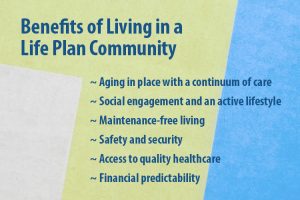As people plan financially for their future, they often seek living arrangements that offer security, social engagement, and healthcare options such as a life plan community. A life plan community is a senior living community that provides a continuum of care, ensuring that residents have access to different levels of support as their needs evolve.
These communities provide independent living, assisted living, and skilled nursing care on campus. This tiered approach ensures that as your healthcare requirements change, you can seamlessly transition to a higher level of care without leaving the community you call home. Life plan communities emphasize maintaining an active lifestyle while offering the peace of mind that there is already a plan in place for future care.
Benefits of Living in a Life Plan Community
Choosing a life plan community offers numerous advantages, making it a preferred option for many older adults and their families. Benefits include the following:
- Aging in place with a continuum of care—One of the most significant benefits of a life plan community is the ability to transition between levels of care within the same community. This eliminates the stress of relocating should health needs change.
- Social engagement and an active lifestyle—Life plan communities emphasize a vibrant and engaging environment with activities such as fitness programs, cultural events, educational classes, and social gatherings. This helps residents maintain an active and fulfilling lifestyle while forming meaningful relationships.
- Maintenance-free living—Residents enjoy a hassle-free lifestyle without the burden of home maintenance, landscaping, or housekeeping. This allows them to focus on personal interests and leisure activities.
- Safety and security—These communities prioritize safety with on-site security, alert pull cords and pendants, and professional staff available to assist residents when needed.
- Access to quality healthcare—With skilled nursing, rehabilitation services, and memory care available on-site, residents and their families have peace of mind knowing that healthcare support is readily accessible.
- Financial predictability—Many life plan communities offer structured payment models, including entrance fees and monthly service fees, which help residents and their families plan for future expenses with greater financial stability.
Understanding the Financial Implications of a Life Plan Community
When considering a move to a life plan community, potential residents need to understand the financial implications. These communities provide stability and peace of mind, but they also come with financial commitments that potential residents should evaluate carefully.
Most communities require proof of sufficient income and assets to cover entrance fees and ongoing monthly fees. This might include a review of your savings, investments, retirement accounts, and any real estate holdings. Some communities offer financial planning resources to help you navigate these requirements and prepare you for long-term living. At Holly Creek, we offer a financial tool called Money Gauge, a personalized questionnaire to help with the financial details of moving to a life plan community.
Initial Entrance Fees and Monthly Costs
The entrance fee is one of the most significant financial aspects of a life plan community. This one-time, upfront cost varies widely based on location, type of residence, and level of care. Entrance fees can range from $100,000 to over $1 million, depending on the community’s amenities and contract type.
Beyond the CCRC entrance fee, residents pay a monthly service fee covering maintenance, utilities, dining, and access to community amenities. These fees can range from $2,000 to $6,000 per month or more, with increases over time due to inflation and rising healthcare costs.
Contract Types and Their Financial Impact
 Life plan communities typically offer different contract options, each with distinct financial considerations:
Life plan communities typically offer different contract options, each with distinct financial considerations:
- Type A (extensive or life care contracts)—This may have higher entrance and monthly fees, but it covers future healthcare costs with little to no increase in monthly rates. Type A is best for those who want predictable costs and long-term stability.
- Type B (modified contracts)—Type B usually has moderate entrance and monthly fees. It generally includes some future healthcare costs but may require additional payments if higher levels of care are needed.
- Type C (fee-for-service contracts)—Residents may pay lower entrance fees with type C, but they will often be responsible for higher out-of-pocket costs for future healthcare. It is best suited for those who can financially handle potential increases in medical expenses.
- Rental contracts—This contract type does not include a large entrance fee, but there are usually higher monthly payments. They typically provide healthcare services on a fee-for-service basis.
Refundability and Estate Planning Considerations
Some life plan communities offer partially or fully refundable entrance fees. These refund structures can be a valuable estate planning tool, ensuring that a portion of the initial investment is returned to heirs or a designated beneficiary.
Reviewing contract details to understand the refund policy and how it aligns with personal financial goals is crucial.
Long-Term Affordability and Financial Stability
Before committing to a life plan community, potential residents should do the following:
- Assess your financial health. Work with a financial advisor to determine affordability based on assets, income, and projected expenses.
- Review the community’s financial stability. Request financial statements and understand their history of fee increases.
- Consider your insurance options. Long-term care insurance may help offset potential healthcare expenses not covered by the contract.
The Importance of a Medical Assessment as Part of Financial Planning for a Life Plan Community
 A medical assessment ensures that the life plan community can provide residents the right level of care. Communities typically offer different levels of care, including independent living, assisted living, skilled nursing, and memory care. Understanding a resident’s current and potential needs helps determine the most suitable placement within the community.
A medical assessment ensures that the life plan community can provide residents the right level of care. Communities typically offer different levels of care, including independent living, assisted living, skilled nursing, and memory care. Understanding a resident’s current and potential needs helps determine the most suitable placement within the community.
Residents should come prepared with a list of all current medications and medical history documents, wear comfortable clothing for physical assessments, and be prepared to discuss any recent hospitalizations, surgeries, or health concerns.
Assessments generally include the following:
- Medical history review, including family history, past and current medical conditions, prescriptions, and over-the-counter medications
- Physical examination, including the assessment of vital signs, evaluation of mobility and physical capabilities, and vision and hearing screening
- Cognitive and mental health assessment, including memory and cognitive function tests to assess potential signs of dementia or cognitive decline, and screening for depression, anxiety, or other mental health conditions
- Functional abilities assessment, including evaluation of the ability to perform daily activities (bathing, dressing, eating, toileting, and mobility) and identification of any assistive devices needed (walkers, wheelchairs, hearing aids)
- Immunization and preventive care review, including a review of vaccination status, including flu, pneumonia, and shingles shots
Contact Holly Creek, a Life Plan Community in Centennial, CO
Choosing a life plan community is a significant financial decision that requires thorough research and careful planning. By understanding entrance fees, contract types, and ongoing costs, you can make informed choices that help ensure financial security and a fulfilling lifestyle in your later years.






